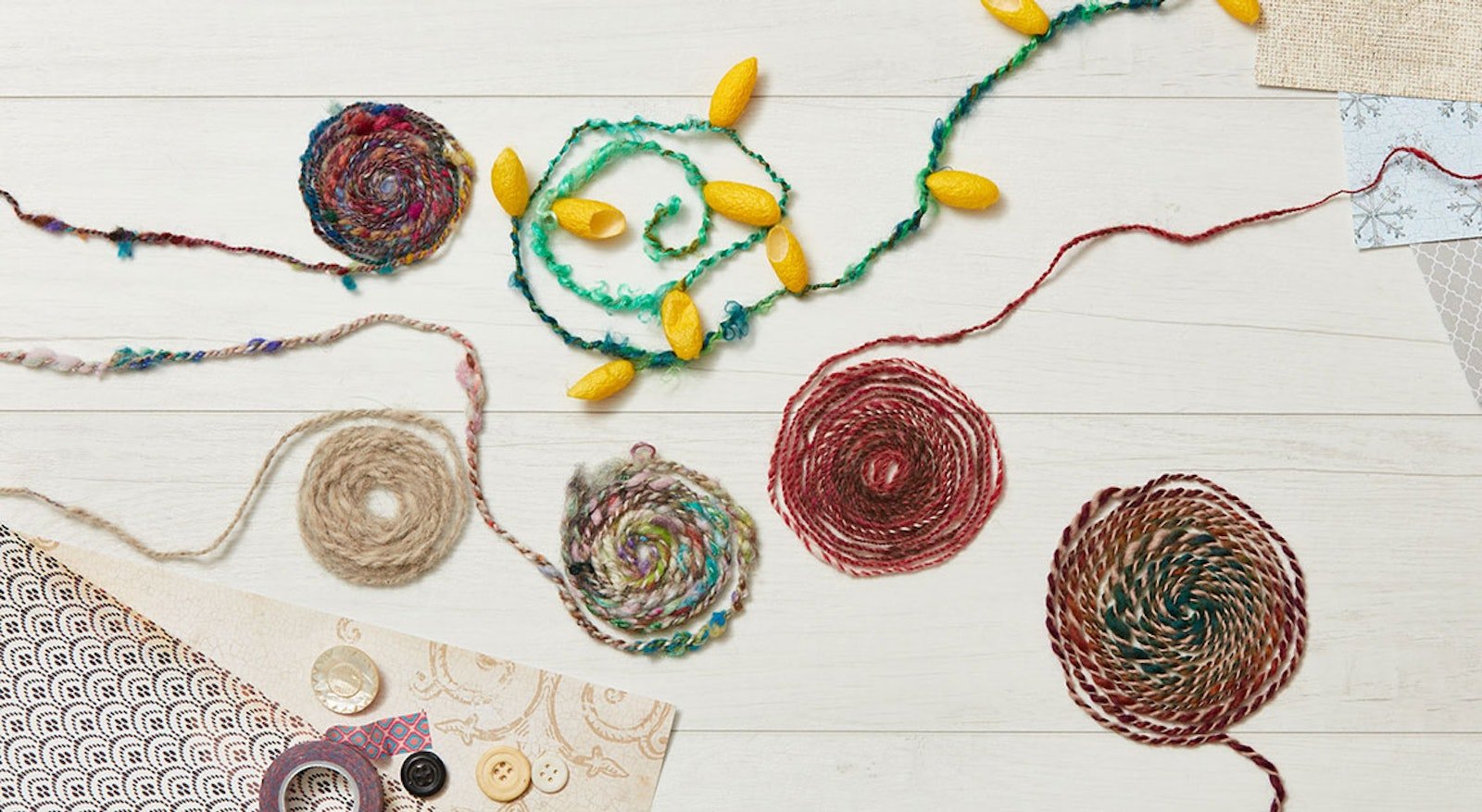What do you make with the leftover fiber that you have collected over the years? Spin it! For the scrap yarn challenge, our readers dove deep into their stashes, uncovered their leftover bits and scraps of spinning fiber, and spun them up into a one-of-a-kind yarn. These mismatched morsels of fibery goodness offered a wonderful design opportunity.
Spinners combed and carded to blend or just winged it and let serendipity guide them. Their efforts transformed their unused scraps of fiber into striking yarns that cannot be duplicated! Just take a look at the submissions.
1. Doris Stephens of Errington, B.C. Canada
Wool, silk, and alpaca; 2-ply; 9 wpi; 575 ypp
“Over the past four years, I collected the discarded fiber (often from the floor!) at my weekly and other various spinning gatherings. When I finally had enough to spin the yarn for my chore sweater, I blended it to homogenize the color, and then carded it and spun a 2-ply yarn. Some color nubs fall out, most don’t. The idea for this yarn came from a Judith MacKenzie seminar discussion on the possible origin of Donegal tweed yarn.”
2. Frankie Pfile of Edmonton, KY
Wool, cotton, bamboo, nylon, silk, Angelina, alpaca, shredded money, mohair, and llama; 2-ply; 7 wpi; 349 ypp
“I tend to keep all of the leftover fibers and yarns from my handspun projects. For this challenge, I took leftover yarn from 10 years’ worth of projects, cut it into 2 to 4-inch pieces, and carded the pieces with bits of leftover fibers. I spun this into singles and then plied two singles into a slightly lumpy, multicolored, multi-fiber yarn. Because these fibers have been collected over so many years, I may have left out some of the fibers in the content. I plan to use this yarn for tea cozies and small purses.”
3. Sylvia Kenyon-Donckels of Molalla, OR
Lhasa Apso, miniature German Shepherd, and cat fur; 2-ply, 6 wpi, 400 ypp
“I spun a 2-ply yarn from J.J., a Lhasa Apso; Maggie May, a miniature German Shepherd; and Baby Bean, a gray cat. I spun this yarn for the brim of my husband’s hat. It will be topped with Shetland wool, the very best fleece I’ve ever spun and my sheep breed of choice.”
4 & 5. Selah Barling of Seattle, WA
Bluefaced Leicester, Merino, mohair, and silk cocoons; corespun and 2-ply; 5 wpi; 38 ypp Bluefaced Leicester, Merino, yak, and silk; 2-ply; 10 wpi; 1,175 ypp
“I redubbed the current challenge of ‘spin scrap’ in my mind as ‘odds and ends’ and then perused my sample bags, class giveaways, leftovers from weaving, and beauty supplies. Silk cocoons are used for facial scrubs in Korea. These cocoons are unused, came from Thailand, and were dyed yellow. The mohair is from one of my favorite sheep farms, The Pines, in Maple Valley, Washington. The cocoon yarn was spun on a spindle. I used a Bluefaced Leicester (BFL) wool single as the core with kid and adult mohair wrapped around it. The cocoons were threaded onto commercial laceweight Merino thrums and plied around the corespun yarn. I made this yarn on April Fools Day.
“The warm wine, brown, and cream yarn was spun on a wheel. It was from at least four fiber bits from classes and sample packs from vendors. It was handcarded, spun, and plied back upon itself.”
6. Dale Jackson of Waterloo, NY
Targhee, 2-ply, 9 wpi, 700 ypp
“These scraps were from a sample box of handpainted Mountain Colors top. The two colors I used were Northern Lights, a multicolored sample, and Wild Mushroom, which is a subtle tan color. It made a nice striped yarn. This was spun on my electric spinner.”
Next Challenge: Spinzilla Yarns
Challenges push us to new levels of accomplishment. They stretch our skill set and help us achieve goals that once seemed out of reach. Spinzilla is one of the spinning world’s ultimate endurance tests—spin as many yards (or meters) as you can in seven days. Spinzilla 2018 takes place October 1–7. Whether you plan to join a team this year or are going rogue, show us your Spinzilla yarns! The deadline to submit is October 22, 2018.
Featured Image: Spinners transformed their unused scraps of fiber into striking yarns that cannot be duplicated. Photos by George Boe



